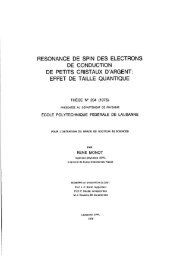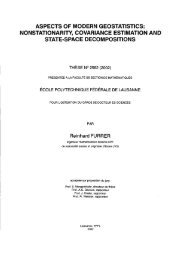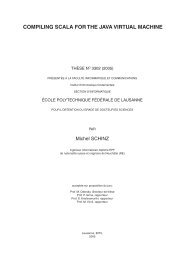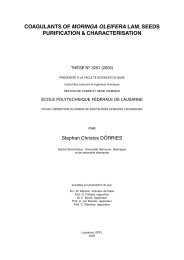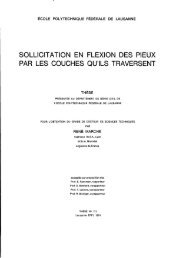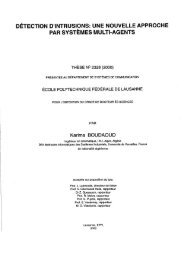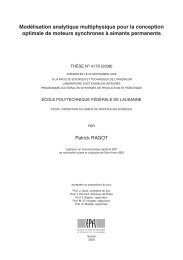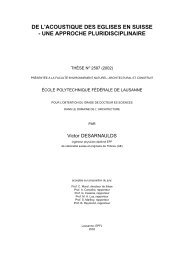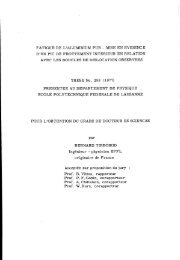Fracture Strength of Structural Glass Elements - Analytical ... - EPFL
Fracture Strength of Structural Glass Elements - Analytical ... - EPFL
Fracture Strength of Structural Glass Elements - Analytical ... - EPFL
Create successful ePaper yourself
Turn your PDF publications into a flip-book with our unique Google optimized e-Paper software.
fracture strength <strong>of</strong> structural glass elements –<br />
analytical and numerical modelling,<br />
testing and design<br />
THÈSE N O 3671 (2006)<br />
PRÉSENTÉE LE 13 DÉCEMBRE 2006<br />
à LA FACULTÉ DE L'ENvIRONNEMENT NATUREL, ARCHITECTURAL ET CONSTRUIT<br />
Laboratoire de la construction métallique<br />
SECTION DE GÉNIE CIvIL<br />
ÉCOLE POLYTECHNIQUE FÉDÉRALE DE LAUSANNE<br />
POUR L'OBTENTION DU GRADE DE DOCTEUR ÈS SCIENCES<br />
PAR<br />
Matthias HALDIMANN<br />
ingénieur diplômé EPF<br />
de nationalité suisse et originaire de Bowil (BE)<br />
acceptée sur proposition du jury:<br />
Pr<strong>of</strong>. A. Schleiss, président du jury<br />
Pr<strong>of</strong>. M.A. Hirt, directeur de thèse<br />
Pr<strong>of</strong>. M.H. Faber, rapporteur<br />
Dr R. Hess, rapporteur<br />
Pr<strong>of</strong>. G. Siebert, rapporteur<br />
Lausanne, <strong>EPFL</strong><br />
2006
Abstract<br />
For centuries, the use <strong>of</strong> glass in buildings was essentially restricted to functions such as windows and<br />
glazing. Over the last decades, continuous improvements in production and refining technologies<br />
have enabled glass elements to carry more substantial superimposed loads and therefore achieve a<br />
more structural role. The structural design <strong>of</strong> such elements, however, remains problematic.<br />
Current widely used design methods suffer from notable shortcomings. They are, for instance, not<br />
applicable to general conditions, but are limited to special cases like rectangular plates, uniform lateral<br />
loads, constant loads, time-independent stress distributions and the like. Some model parameters<br />
combine several physical aspects, so that they depend on the experimental setup used for their<br />
determination. The condition <strong>of</strong> the glass surface is not represented by user-modifiable parameters,<br />
but is embedded implicitly. The design methods contain inconsistencies and give unrealistic results<br />
for special cases. Different models yield differing results and several researchers have expressed<br />
fundamental doubts about the suitability and correctness <strong>of</strong> common glass design methods. The lack<br />
<strong>of</strong> confidence in ‘advanced’ glass models and the absence <strong>of</strong> a generally agreed design method result<br />
in frequent time-consuming and expensive laboratory testing and in inadequately designed structural<br />
glass elements. The present thesis endeavours to improve this situation.<br />
After outlining the fundamental aspects <strong>of</strong> the use <strong>of</strong> glass as a building material, an analysis <strong>of</strong><br />
present knowledge was conducted in order to provide a focus for subsequent investigations. Then a<br />
lifetime prediction model for structural glass elements was established based on fracture mechanics<br />
and the theory <strong>of</strong> probability. Aiming at consistency, flexibility, and a wide field <strong>of</strong> application,<br />
this model <strong>of</strong>fers significant advantages over currently used models. It contains, for instance, no<br />
simplifying hypotheses that would restrict its applicability to special cases and it <strong>of</strong>fers great flexibility<br />
with regard to the representation <strong>of</strong> the surface condition. In a next step, possible simplifications <strong>of</strong><br />
the model and the availability <strong>of</strong> the model’s required input data were discussed. In addition to the<br />
analysis <strong>of</strong> existing data, laboratory tests were performed and testing procedures improved in order<br />
to provide more reliable and accurate model input.<br />
In the last part <strong>of</strong> the work, recommendations for structural design and testing were developed.<br />
They include, among other things, the following:<br />
◆ <strong>Glass</strong> elements that are permanently protected from damage can be designed by extrapolation <strong>of</strong><br />
experimental data obtained from as-received or homogeneously damaged specimens. The design<br />
<strong>of</strong> exposed glass elements whose surfaces may be damaged during their service lives (for example,<br />
because <strong>of</strong> accidental impact or vandalism), however, should be based on a realistic estimation <strong>of</strong><br />
the potential damage (design flaw). Appropriate predictive models and testing procedures are<br />
proposed in this thesis.<br />
◆ If substantial surface damage has to be considered, the inherent strength contributes little to the<br />
resistance <strong>of</strong> heat treated glass. Therefore, quality control measures that allow the use <strong>of</strong> a high<br />
design value for the residual surface stress are very efficient in terms <strong>of</strong> economical material use.<br />
◆ Results from laboratory testing at ambient conditions represent a combination <strong>of</strong> surface condition<br />
and crack growth. The strong stress rate dependence <strong>of</strong> the latter, which was demonstrated in<br />
this thesis, diminishes the accuracy and reliability <strong>of</strong> the results. The problem can be addressed<br />
by the near-inert testing procedure that was developed and used in this thesis.<br />
The application <strong>of</strong> the proposed models and recommendations in research and practice is facilitated<br />
by <strong>Glass</strong>Tools, the computer s<strong>of</strong>tware that was developed as part <strong>of</strong> this thesis.<br />
Keywords: Design method, fracture mechanics, fracture strength, laboratory testing procedure, predictive<br />
modelling, structural design, structural glass elements, surface flaws, resistance.<br />
i
Zusammenfassung<br />
Während Jahrhunderten wurde Glas in Gebäuden praktisch ausschliesslich für Fenster und Verglasungen<br />
eingesetzt. In den letzten Jahrzehnten haben Fortschritte in der Herstellung und Verarbeitung<br />
von Glas den zunehmenden Einsatz von Glasbauteilen für lastabtragende Elemente ermöglicht. Die<br />
Bemessung solcher Bauteile bleibt jedoch problematisch.<br />
Die gängigen Bemessungsmethoden weisen wesentliche Mängel auf. Sie sind beispielsweise nicht<br />
allgemein anwendbar, sondern auf Spezialfälle wie rechteckige <strong>Glass</strong>cheiben, gleichmässig verteilte<br />
Flächenlasten, konstante Lasten, zeitunabhängige Spannungsverteilungen und dergleichen<br />
beschränkt. Einige Modellparameter kombinieren mehrere physikalische Aspekte und hängen daher<br />
von der zu ihrer Bestimmung verwendeten Versuchseinrichtung ab. Der Zustand der Glasoberfläche<br />
wird nicht durch vom Anwender anpassbare Parameter berücksichtigt, sondern ist implizit im Modell<br />
enthalten. Darüber hinaus sind die Bemessungskonzepte nicht durchgängig konsistent, sie führen<br />
zu unrealistischen Resultaten für Spezialfälle und die Ergebnisse der Modelle unterscheiden sich<br />
deutlich. Verschiedene Forscher äusserten sogar grundlegende Zweifel an der Zweckmässigkeit und<br />
Richtigkeit gängiger Bemessungsmethoden. Die weitverbreitete Skepsis gegenüber ‘fortgeschrittenen’<br />
Modellen und das Fehlen einer allgemein anerkannten Bemessungsmethode führen zu häufigen<br />
zeit- und kostenintensiven Laborversuchen und zu unzulänglich bemessenen Glasbauteilen. Diese<br />
Situation zu verbessern ist das Ziel der vorliegenden Dissertation.<br />
Nach einem kurzen Überblick über die grundlegenden Aspekte des Einsatzes von Glas als Baust<strong>of</strong>f<br />
wird der aktuelle Wissensstand analysiert, um die nachfolgenden Untersuchungen zu fokussieren.<br />
Anschliessend wird auf der Basis der linear elastischen Bruchmechanik und der Wahrscheinlichkeitstheorie<br />
ein möglichst allgemeines, konsistentes und flexibles Modell zur Vorhersage der Lebensdauer<br />
von Bauteilen aus Glas entwickelt. Dieses bietet gegenüber gängigen Modellen wesentliche Vorteile.<br />
Es enthält beispielsweise keine den Anwendungsbereich einschränkenden Annahmen und bietet<br />
grosse Flexibilität bei der Modellierung des Oberflächenzustandes. Möglichkeiten zur Vereinfachung<br />
des Modells sowie die Verfügbarkeit der benötigten Eingabedaten werden diskutiert. Neben der Analyse<br />
publizierter Daten werden dazu auch eigene Laborversuche durchgeführt. Schliesslich werden<br />
bestehende Prüfverfahren in Bezug auf die Zuverlässigkeit und Genauigkeit der Ergebnisse optimiert.<br />
Im letzten Teil der vorliegenden Arbeit werden Empfehlungen für die Bemessung sowie für die<br />
Durchführung von Laborversuchen erarbeitet. Es wird unter anderem Folgendes festgestellt:<br />
◆ Für dauerhaft vor Beschädigung geschützte Glasbauteile liefert eine Bemessung durch Extrapolation<br />
der Ergebnisse von Versuchen an neuen oder homogen vorgeschädigten Gläsern sinnvolle<br />
Ergebnisse. Exponierte Elemente, deren Oberfläche während der Lebensdauer z. B. durch Anprall<br />
oder Vandalismus beschädigt werden könnte, sollten jedoch anhand einer realistischen Abschätzung<br />
der potentiellen Beschädigung (Bemessungsriss) bemessen werden. Entsprechende Modelle<br />
und Laborversuche werden vorgeschlagen.<br />
◆ Wenn wesentliche Oberflächenschädigungen zu berücksichtigen sind, trägt die Glaseigenfestigkeit<br />
nur wenig zum Widerstand von thermisch vorgespannten Gläsern bei. Qualitätssicherungsmassnahmen,<br />
welche die Verwendung eines hohen Bemessungswertes der Druckeigenspannung<br />
ermöglichen, sind daher sehr effektiv im Hinblick auf eine optimale Materialausnutzung.<br />
◆ Ergebnisse aus Laborversuchen in normaler Umgebung werden sowohl durch den Oberflächenzustand<br />
als auch durch das unterkritische Risswachstum beeinflusst. Die Tatsache, dass das<br />
Risswachstum wie in dieser Dissertation gezeigt stark von der Belastungsgeschwindigkeit abhängt,<br />
reduziert die Genauigkeit und Sicherheit der Ergebnisse. Das Problem wird mit dem in der<br />
vorliegenden Arbeit entwickelten und angewendeten quasi-inerten Prüfverfahren vermieden.<br />
Die Anwendung der Modelle und Empfehlungen in Forschung und Praxis wird duch <strong>Glass</strong>Tools, eine<br />
im Rahmen dieser Arbeit entwickelte S<strong>of</strong>tware, wesentlich vereinfacht und beschleunigt.<br />
Stichworte: Bemessungsmethode, Bruchmechanik, Bruchfestigkeit, Prüfverfahren, Modellierung, Bemessung,<br />
tragende Glasbauteile, Oberflächenschädigung, Tragwiderstand.<br />
ii
Résumé<br />
Depuis des siècles, l’utilisation du verre dans les bâtiments était limitée essentiellement à ses fonctions<br />
de fenêtres et vitrages. Au cours des dernières décennies, des progrès constants, réalisés aussi bien<br />
dans la production que dans les techniques de traitement du verre, ont permis de développer des<br />
éléments en verre capables de supporter des charges utiles importantes, leur permettant ainsi de<br />
jouer un rôle structural. Cependant, le dimensionnement de tels éléments porteurs reste encore<br />
problématique.<br />
Les méthodes de dimensionnement usuelles souffrent d’insuffisances considérables. Elles ne sont par<br />
exemple pas applicables aux cas généraux, mais sont limitées aux cas particuliers comme les panneaux<br />
rectangulaires, les charges transversales uniformément réparties, les forces constantes, les répartitions<br />
de contraintes indépendantes du temps, etc. Certains paramètres combinent plusieurs phénomènes<br />
physiques, si bien qu’ils dépendent du schéma expérimental qui a servi à leur détermination. L’état<br />
de surface du verre n’est pas modélisé par des paramètres qui peuvent être définis par l’utilisateur,<br />
mais est pris en considération implicitement. Les méthodes de dimensionnement contiennent des<br />
contradictions et peuvent donner des résultats non réalistes dans des cas particuliers. Des modèles<br />
différents conduisent à des résultats différents pour la même application. Enfin plusieurs chercheurs<br />
ont exprimé de sérieux doutes quant à l’applicabilité et la justesse des méthodes usuelles de calcul des<br />
éléments en verre. Le manque de confiance dans des modèles plus ‘sophistiqués’ ainsi que l’absence<br />
de méthodes universellement approuvées conduisent à la réalisation d’essais en laboratoire longs et<br />
coûteux et à des dimensionnements inadéquats d’éléments structuraux en verre. La présente thèse a<br />
pour objectif d’améliorer cette situation.<br />
Après avoir rappelé les aspects fondamentaux de l’utilisation du verre en tant que matériau<br />
de construction, l’auteur a procédé à une analyse des connaissances actuelles de façon à définir<br />
l’orientation des recherches à poursuivre. Ensuite, un modèle de prévision de la durée de vie des<br />
éléments en verre, le plus cohérent, général et souple possible, a été établi sur la base de la mécanique<br />
de la rupture et de la théorie des probabilités. Ce modèle <strong>of</strong>fre de nombreux avantages par rapport<br />
aux modèles existants: il ne contient par exemple aucune hypothèse simplificatrice qui limiterait<br />
son application à des cas spéciaux et il <strong>of</strong>fre une grande souplesse dans la représentation de l’état<br />
de surface. L’étape suivante a consisté à discuter des éventuelles simplifications du modèle et de la<br />
disponibilité des données nécessaires à introduire dans le modèle. Enfin, en plus de l’analyse des<br />
résultats expérimentaux existants, des essais en laboratoire ont été effectués et des modes opératoires<br />
ont été améliorés de façon à fournir au modèle des données plus fiables et plus précises.<br />
Dans la dernière partie de la thèse, des recommandations ont été proposées pour le dimensionnement<br />
structural et la réalisation des essais. Ces recommandations comprennent entre autres choses<br />
les points suivants:<br />
◆ Les éléments en verre qui sont protégés en permanence vis-à-vis d’endommagements de surface<br />
peuvent être dimensionnés à partir de résultats d’essai obtenus sur des éprouvettes neuves ou<br />
endommagées uniformément. Le dimensionnement d’éléments en verre exposés, dont la surface<br />
peut subir des endommagements pendant sa durée de service (chocs, vandalisme), doit par contre<br />
être basé sur une estimation réaliste du dommage potentiel (défaut de calcul). Des modèles de<br />
prévision appropriés et des modes opératoires sont proposés dans la thèse.<br />
◆ Si un dommage de surface important doit être pris en considération lors du dimensionnement<br />
d’un verre trempé thermiquement, la résistance intrinsèque du verre participe peu à la résistance.<br />
C’est pourquoi des mesures de contrôle de qualité, qui permettent de tenir compte d’une valeur<br />
élevée des contraintes résiduelles, sont très efficaces en vue d’une utilisation économique de<br />
matériau.<br />
◆ Les résultats d’essai en laboratoire sous conditions ambiantes représentent une combinaison de<br />
l’état de surface et de l’accroissement des fissures. La forte dépendance de cet accroissement à la<br />
vitesse de contrainte, démontrée dans ce projet de recherche, diminue la précision et la fiabilité<br />
iii
des résultats. Le problème peut être résolu à l’aide d’essais réalisés selon le mode opératoire<br />
‘quasi-inerte’ développé et utilisé dans cette thèse.<br />
Le logiciel <strong>Glass</strong>Tools, développé par l’auteur dans le cadre de cette thèse, facilite l’application, aussi<br />
bien en recherche qu’en pratique, des modèles et recommandations proposés.<br />
Mots-clés: Méthode de dimensionnement, mécanique de la rupture, résistance à la rupture, mode<br />
opératoire, modèle de prévision, dimensionnement, éléments structuraux en verre, anomalie de surface,<br />
résistance<br />
iv
Contents<br />
Abstract i<br />
Zusammenfassung ii<br />
Résumé iii<br />
Acknowledgements v<br />
Contents vii<br />
Notation, Definitions, Terminology xi<br />
General information . . . . . . . . . . . . . . . . . . . . . . . . . . . . . . . . . . . . . . . . . . . xi<br />
Latin symbols . . . . . . . . . . . . . . . . . . . . . . . . . . . . . . . . . . . . . . . . . . . . . . . xi<br />
Greek symbols . . . . . . . . . . . . . . . . . . . . . . . . . . . . . . . . . . . . . . . . . . . . . . . xiii<br />
Generally used indices and superscripts . . . . . . . . . . . . . . . . . . . . . . . . . . . . . . xiv<br />
Functions and mathematical notation . . . . . . . . . . . . . . . . . . . . . . . . . . . . . . . xiv<br />
Abbreviations . . . . . . . . . . . . . . . . . . . . . . . . . . . . . . . . . . . . . . . . . . . . . . . xiv<br />
Glossary <strong>of</strong> Terms xv<br />
1 Introduction 1<br />
1.1 Background and motivation . . . . . . . . . . . . . . . . . . . . . . . . . . . . . . . . . . 1<br />
1.2 Main objectives . . . . . . . . . . . . . . . . . . . . . . . . . . . . . . . . . . . . . . . . . . 3<br />
1.3 Organization <strong>of</strong> the thesis . . . . . . . . . . . . . . . . . . . . . . . . . . . . . . . . . . . . 3<br />
2 <strong>Glass</strong> for Use in Buildings 5<br />
2.1 Production <strong>of</strong> flat glass . . . . . . . . . . . . . . . . . . . . . . . . . . . . . . . . . . . . . 5<br />
2.2 Material properties . . . . . . . . . . . . . . . . . . . . . . . . . . . . . . . . . . . . . . . . 6<br />
2.2.1 Composition and chemical properties . . . . . . . . . . . . . . . . . . . . . . . . . 6<br />
2.2.2 Physical properties . . . . . . . . . . . . . . . . . . . . . . . . . . . . . . . . . . . . 8<br />
2.3 Processing and glass products . . . . . . . . . . . . . . . . . . . . . . . . . . . . . . . . . 9<br />
2.3.1 Introduction . . . . . . . . . . . . . . . . . . . . . . . . . . . . . . . . . . . . . . . . 9<br />
2.3.2 Tempering <strong>of</strong> glass . . . . . . . . . . . . . . . . . . . . . . . . . . . . . . . . . . . . 10<br />
2.3.3 Laminated glass . . . . . . . . . . . . . . . . . . . . . . . . . . . . . . . . . . . . . . 13<br />
vii
3 State <strong>of</strong> Knowledge – Overview and Analysis 15<br />
3.1 Laboratory testing procedures . . . . . . . . . . . . . . . . . . . . . . . . . . . . . . . . . 15<br />
3.1.1 Static fatigue tests . . . . . . . . . . . . . . . . . . . . . . . . . . . . . . . . . . . . . 15<br />
3.1.2 Dynamic fatigue tests . . . . . . . . . . . . . . . . . . . . . . . . . . . . . . . . . . . 15<br />
3.1.3 Direct measurement <strong>of</strong> the growth <strong>of</strong> large through-thickness cracks . . . . . 17<br />
3.1.4 Tests for the glass failure prediction model . . . . . . . . . . . . . . . . . . . . . 17<br />
3.2 Design methods . . . . . . . . . . . . . . . . . . . . . . . . . . . . . . . . . . . . . . . . . . 17<br />
3.2.1 Introduction . . . . . . . . . . . . . . . . . . . . . . . . . . . . . . . . . . . . . . . . 17<br />
3.2.2 Allowable stress based methods . . . . . . . . . . . . . . . . . . . . . . . . . . . . 17<br />
3.2.3 DELR design method . . . . . . . . . . . . . . . . . . . . . . . . . . . . . . . . . . . 18<br />
3.2.4 European draft standard prEN 13474 . . . . . . . . . . . . . . . . . . . . . . . . . 20<br />
3.2.5 Design method <strong>of</strong> Shen . . . . . . . . . . . . . . . . . . . . . . . . . . . . . . . . . 22<br />
3.2.6 Design method <strong>of</strong> Siebert . . . . . . . . . . . . . . . . . . . . . . . . . . . . . . . . 23<br />
3.2.7 <strong>Glass</strong> failure prediction model (GFPM) . . . . . . . . . . . . . . . . . . . . . . . . 25<br />
3.2.8 American National Standard ASTM E 1300 . . . . . . . . . . . . . . . . . . . . . 25<br />
3.2.9 Canadian National Standard CAN/CGSB 12.20 . . . . . . . . . . . . . . . . . . . 27<br />
3.3 Analysis <strong>of</strong> current glass design methods . . . . . . . . . . . . . . . . . . . . . . . . . . 29<br />
3.3.1 Introduction . . . . . . . . . . . . . . . . . . . . . . . . . . . . . . . . . . . . . . . . 29<br />
3.3.2 Main concepts . . . . . . . . . . . . . . . . . . . . . . . . . . . . . . . . . . . . . . . 29<br />
3.3.3 Obtaining design parameters from experiments . . . . . . . . . . . . . . . . . . 29<br />
3.3.4 Load duration effects . . . . . . . . . . . . . . . . . . . . . . . . . . . . . . . . . . . 30<br />
3.3.5 Residual stress . . . . . . . . . . . . . . . . . . . . . . . . . . . . . . . . . . . . . . . 32<br />
3.3.6 Size effect . . . . . . . . . . . . . . . . . . . . . . . . . . . . . . . . . . . . . . . . . . 32<br />
3.3.7 Weibull statistics . . . . . . . . . . . . . . . . . . . . . . . . . . . . . . . . . . . . . . 33<br />
3.3.8 Biaxial stress fields . . . . . . . . . . . . . . . . . . . . . . . . . . . . . . . . . . . . 33<br />
3.3.9 Consistency and field <strong>of</strong> application . . . . . . . . . . . . . . . . . . . . . . . . . . 34<br />
3.3.10 Additional information and quality control . . . . . . . . . . . . . . . . . . . . . 34<br />
3.4 Summary and Conclusions . . . . . . . . . . . . . . . . . . . . . . . . . . . . . . . . . . . 35<br />
4 Lifetime Prediction Model 37<br />
4.1 Stress corrosion and subcritical crack growth . . . . . . . . . . . . . . . . . . . . . . . 37<br />
4.1.1 Introduction and terminology . . . . . . . . . . . . . . . . . . . . . . . . . . . . . 37<br />
4.1.2 The classic stress corrosion theory . . . . . . . . . . . . . . . . . . . . . . . . . . . 37<br />
4.1.3 Relationship between crack velocity and stress intensity . . . . . . . . . . . . . 38<br />
4.1.4 Chemical background . . . . . . . . . . . . . . . . . . . . . . . . . . . . . . . . . . 40<br />
4.1.5 Crack healing, crack growth threshold and hysteresis effect . . . . . . . . . . . 40<br />
4.1.6 Influences on the relationship between stress intensity and crack growth . . . 41<br />
4.2 Mechanical behaviour <strong>of</strong> a single surface flaw . . . . . . . . . . . . . . . . . . . . . . 43<br />
4.2.1 <strong>Fracture</strong> mechanics basics . . . . . . . . . . . . . . . . . . . . . . . . . . . . . . . . 43<br />
4.2.2 Inert strength . . . . . . . . . . . . . . . . . . . . . . . . . . . . . . . . . . . . . . . 44<br />
4.2.3 Heat treated glass . . . . . . . . . . . . . . . . . . . . . . . . . . . . . . . . . . . . . 45<br />
4.2.4 Subcritical crack growth and lifetime . . . . . . . . . . . . . . . . . . . . . . . . . 45<br />
4.2.5 Equivalent static stress and resistance . . . . . . . . . . . . . . . . . . . . . . . . 46<br />
4.2.6 Constant stress and constant stress rate . . . . . . . . . . . . . . . . . . . . . . . 48<br />
4.3 Extension to a random surface flaw population . . . . . . . . . . . . . . . . . . . . . . 49<br />
4.3.1 Starting point and hypotheses . . . . . . . . . . . . . . . . . . . . . . . . . . . . . 49<br />
4.3.2 Constant, uniform, uniaxial stress . . . . . . . . . . . . . . . . . . . . . . . . . . . 49<br />
4.3.3 Extension to non-uniform, biaxial stress fields . . . . . . . . . . . . . . . . . . . 52<br />
4.3.4 Extension to time-dependent loading . . . . . . . . . . . . . . . . . . . . . . . . . 54<br />
4.3.5 Extension to account for subcritical crack growth . . . . . . . . . . . . . . . . . 54<br />
4.4 Summary and Conclusions . . . . . . . . . . . . . . . . . . . . . . . . . . . . . . . . . . . 56<br />
viii
5 Discussion and Simplification <strong>of</strong> the Model 57<br />
5.1 Assessment <strong>of</strong> the main hypotheses behind the model . . . . . . . . . . . . . . . . . 57<br />
5.1.1 Introduction . . . . . . . . . . . . . . . . . . . . . . . . . . . . . . . . . . . . . . . . 57<br />
5.1.2 <strong>Strength</strong> data . . . . . . . . . . . . . . . . . . . . . . . . . . . . . . . . . . . . . . . 58<br />
5.1.3 In-service conditions . . . . . . . . . . . . . . . . . . . . . . . . . . . . . . . . . . . 60<br />
5.1.4 Conclusions . . . . . . . . . . . . . . . . . . . . . . . . . . . . . . . . . . . . . . . . . 61<br />
5.2 Assessment <strong>of</strong> the relevance <strong>of</strong> some fundamental aspects . . . . . . . . . . . . . . 62<br />
5.2.1 The risk integral . . . . . . . . . . . . . . . . . . . . . . . . . . . . . . . . . . . . . . 62<br />
5.2.2 The crack growth threshold . . . . . . . . . . . . . . . . . . . . . . . . . . . . . . . 64<br />
5.2.3 Biaxial stress fields . . . . . . . . . . . . . . . . . . . . . . . . . . . . . . . . . . . . 66<br />
5.3 Simplification for special cases . . . . . . . . . . . . . . . . . . . . . . . . . . . . . . . . 71<br />
5.3.1 <strong>Structural</strong> Design . . . . . . . . . . . . . . . . . . . . . . . . . . . . . . . . . . . . . 71<br />
5.3.2 Avoiding transient finite element analyses . . . . . . . . . . . . . . . . . . . . . . 72<br />
5.3.3 Common testing procedures . . . . . . . . . . . . . . . . . . . . . . . . . . . . . . 75<br />
5.4 Relating current design methods to the lifetime prediction model . . . . . . . . . 76<br />
5.5 Summary and Conclusions . . . . . . . . . . . . . . . . . . . . . . . . . . . . . . . . . . . 78<br />
6 Quantification <strong>of</strong> the Model Parameters 79<br />
6.1 Introduction . . . . . . . . . . . . . . . . . . . . . . . . . . . . . . . . . . . . . . . . . . . . 79<br />
6.2 Basic fracture mechanics parameters . . . . . . . . . . . . . . . . . . . . . . . . . . . . 80<br />
6.3 Crack velocity parameters . . . . . . . . . . . . . . . . . . . . . . . . . . . . . . . . . . . . 82<br />
6.4 Ambient strength data . . . . . . . . . . . . . . . . . . . . . . . . . . . . . . . . . . . . . . 86<br />
6.5 Analysing large-scale experiments . . . . . . . . . . . . . . . . . . . . . . . . . . . . . . 88<br />
6.6 Residual surface stress data . . . . . . . . . . . . . . . . . . . . . . . . . . . . . . . . . . 92<br />
6.7 Summary and Conclusions . . . . . . . . . . . . . . . . . . . . . . . . . . . . . . . . . . . 95<br />
7 Experimental Investigations 97<br />
7.1 Objectives . . . . . . . . . . . . . . . . . . . . . . . . . . . . . . . . . . . . . . . . . . . . . . 97<br />
7.2 Test setup and measurements . . . . . . . . . . . . . . . . . . . . . . . . . . . . . . . . . 98<br />
7.3 Creating near-inert conditions in laboratory tests . . . . . . . . . . . . . . . . . . . . 104<br />
7.4 Deep close-to-reality surface flaws . . . . . . . . . . . . . . . . . . . . . . . . . . . . . . 105<br />
7.4.1 Testing procedure . . . . . . . . . . . . . . . . . . . . . . . . . . . . . . . . . . . . . 105<br />
7.4.2 Experiments and results . . . . . . . . . . . . . . . . . . . . . . . . . . . . . . . . . 108<br />
7.4.3 Is hermetic coating indispensable for deep flaw testing? . . . . . . . . . . . . . 110<br />
7.5 Visual detectability <strong>of</strong> deep surface flaws . . . . . . . . . . . . . . . . . . . . . . . . . . 111<br />
7.6 Summary and Conclusions . . . . . . . . . . . . . . . . . . . . . . . . . . . . . . . . . . . 114<br />
8 <strong>Structural</strong> Design <strong>of</strong> <strong>Glass</strong> <strong>Elements</strong> 115<br />
8.1 Introduction . . . . . . . . . . . . . . . . . . . . . . . . . . . . . . . . . . . . . . . . . . . . 115<br />
8.2 The structural design process . . . . . . . . . . . . . . . . . . . . . . . . . . . . . . . . . 116<br />
8.3 Characteristics <strong>of</strong> the two surface condition models . . . . . . . . . . . . . . . . . . . 116<br />
8.3.1 Single surface flaw model . . . . . . . . . . . . . . . . . . . . . . . . . . . . . . . . 116<br />
8.3.2 Random surface flaw population model . . . . . . . . . . . . . . . . . . . . . . . 118<br />
8.4 Recommendations . . . . . . . . . . . . . . . . . . . . . . . . . . . . . . . . . . . . . . . . . 123<br />
8.4.1 <strong>Structural</strong> design . . . . . . . . . . . . . . . . . . . . . . . . . . . . . . . . . . . . . 123<br />
8.4.2 Testing . . . . . . . . . . . . . . . . . . . . . . . . . . . . . . . . . . . . . . . . . . . . 125<br />
8.4.3 Overview <strong>of</strong> mathematical relationships . . . . . . . . . . . . . . . . . . . . . . . 126<br />
8.5 S<strong>of</strong>tware . . . . . . . . . . . . . . . . . . . . . . . . . . . . . . . . . . . . . . . . . . . . . . . 128<br />
8.5.1 Introduction and scope . . . . . . . . . . . . . . . . . . . . . . . . . . . . . . . . . . 128<br />
8.5.2 Discretization <strong>of</strong> the failure prediction model . . . . . . . . . . . . . . . . . . . . 128<br />
ix
8.5.3 Implementation . . . . . . . . . . . . . . . . . . . . . . . . . . . . . . . . . . . . . . 130<br />
8.5.4 Features and usage notes . . . . . . . . . . . . . . . . . . . . . . . . . . . . . . . . 132<br />
8.6 Action modelling . . . . . . . . . . . . . . . . . . . . . . . . . . . . . . . . . . . . . . . . . 133<br />
8.7 Summary and Conclusions . . . . . . . . . . . . . . . . . . . . . . . . . . . . . . . . . . . 134<br />
9 Summary, Conclusions, and Further Research 137<br />
9.1 Summary . . . . . . . . . . . . . . . . . . . . . . . . . . . . . . . . . . . . . . . . . . . . . . 137<br />
9.2 How this work’s objectives were reached . . . . . . . . . . . . . . . . . . . . . . . . . . 137<br />
9.3 Main conclusions . . . . . . . . . . . . . . . . . . . . . . . . . . . . . . . . . . . . . . . . . 138<br />
9.4 Further research . . . . . . . . . . . . . . . . . . . . . . . . . . . . . . . . . . . . . . . . . . 141<br />
References 143<br />
A Overview <strong>of</strong> European Standards 153<br />
B On the Derivation <strong>of</strong> the Lifetime Prediction Model 155<br />
C <strong>EPFL</strong>-ICOM Laboratory Testing Information and Data 157<br />
D Ontario Research Foundation Experimental Data 161<br />
E Statistical Fundamentals 165<br />
F Predictive Modelling Example 169<br />
G Source Code Listings 171<br />
H Documentation for the ‘<strong>Glass</strong>Tools’ S<strong>of</strong>tware 179<br />
Index 197<br />
Curriculum vitae 201<br />
x



